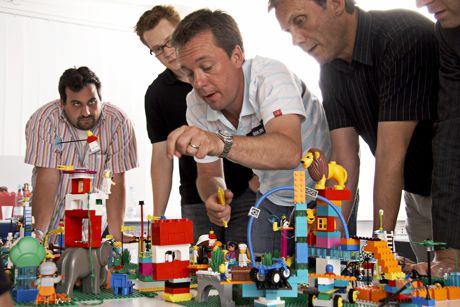Katie Dwyer, an agile consultant for Seapine, stands in front a whiteboard, sticky notes at the ready. On the board is a drawing of the ocean out to the horizon, with a sailboat above and the sea below. In the room is the agile development team at software provider Seapine, ready to do a retrospective about the last project they worked on.
Development team members shout out what they think went well in the last iteration of software they create, and Dwyer places those notes in the sails, representing wind that propelled the project forward. Next, they proclaim what went wrong, and those sticky notes are placed in the sea as an anchor, representing drag on the project. Anchors can be placed close to the bottom of the boat, representing a small issue, or deep in the sea, representing a larger conflict.
This agile development exercise is actually a game called Speed Boat, created by Luke Hohmann, founder and CEO of The Innovation Games Company. Speed Boat is part of the 12 original games he created to facilitate work through games.
According to Innovation Games’ website, the rules are identical to how Seapine’s team plays: using anchors as negatives and wind in the sails as positives. The bigger picture, though, is that game-playing can engage team members who might otherwise be reticent to offer input into processes and projects. In that regard, using these games is not just playing around.
Game start
Alan Bustamante, a senior agile consultant, has been working with Innovation Games for two years and decided to bring it to Seapine when he joined Seapine in August of last year.
“If a team is new to games, I’ll start with something I’m familiar with first. The word ‘game’ is sometimes negative, so we’ll say an exercise. Games are becoming part of the agile culture,” he said.
Dwyer added that Speed Boat was introduced to the team as an exercise, and a way of allowing all the voices in the team to be heard.
Agile games, according to Hohmann, are used to teach agile principles, something Michael McCullough, senior technical director at Quadrus Development, agrees with.
McCullough is a founding member of TastyCupcakes.org, a website that houses instructions and descriptions of agile games, and he is trying to build a community around the concepts. The games, he said, foster a greater understanding of how developers as a team do work.
“I use these games as techniques to help communicate difficult principles and values of agile development and practices,” McCullough said, adding that often these games are used to help teams discover, individually as employees and collectively as a team, what isn’t working in their development process.
“Games are a powerful way to help achieve self-discovery; they teach you how to interact and work together,” he said. “A lot of games we focus on are communication practices so teams can apply the agile practices—requirements gathering, user stories—outside of the game.”
 The games can be used by organizations trying agile for the first time or by organizations who have implemented the methodology but wish to become more productive.
The games can be used by organizations trying agile for the first time or by organizations who have implemented the methodology but wish to become more productive.
One of the most well known agile games—99 Test Balloons—teaches software developers how to gather requirements and what conversations are essential to that process.
Other games, like White Elephant Sizing, allow developers and team members to first understand an agile process and then carry out the process, according to McCullough.
“Games are techniques to open people’s minds; they teach people to innovate while providing a framework for discussing how to change their development processes as the world continues to change,” he said.
Building a successful program
These two games teach teams how to do agile and facilitate their work, in addition to fostering discussion and self-exploration. Lego Serious Play, an online community formerly owned by the Lego toy company, is another tool that agile teams can use to discuss how they work and how they can change their methods from one iteration to another.
Dave Laribee, an agile coach and internal product team coach at VersionOne (a provider of agile software tools), has used Innovation Games at the company and is now looking into using Lego Serious Play as a tool for his product management teams in their release-level retrospective sessions.
VersionOne has large teams of 17 to 18 people, and Laribee said he found that the old forum-like sessions didn’t encourage all members to speak up, particularly those who might be more introverted than their colleagues. Lego Serious Play, according to Michael McNally, director of brand relations at Lego, not only encourages all team members to speak, but also presents ideas and concepts people may not be able to verbalize.
“Lego is a strategic methodology and Innovation Games are tactical; both are really useful,” said Laribee. “Lego levels out a team because everyone is building at the same rate, and then they all have a product [building blocks that demonstrate a set of simple guiding principles for the next release] to discuss. I hope the quality of the product is better.”
“Lego was designed to create a learning experience using the Lego bricks as a medium,” said Robert Rasmussen, principal of Rasmussen Consulting, adding that the real “Ah ha!” moment came when he used the Lego Serious Play methodology within his own research and development team. His experience with Lego Serious Play came from his experience as an educator and as a former employee of Lego. He now owns his own consulting firm and provides Lego Serious Play facilitator training to companies and managers around the world.
“Lego Serious Play gets people to realize what they know. It works well where people want to contribute and management values the ideas of the team,” he said.
The Lego Serious Play blocks are like a vocabulary; some are shapes, some are translucent, and some are a variety of shapes and themes, like gears and animals. Each block helps team members to tell a story, according to Rasmussen. The open-source model for the Lego Serious Play methodology, in his opinion, is great because it allows people to realize that Lego Serious Play goes beyond the bricks and into a methodology, all the while making a dull process into a fun one, which is what gaming is all about.
#!
“Serious play gets people thinking creatively with their brain, words and hands; we’ve found that when you put creative material in front of people, they are better able to articulate things they aren’t comfortable saying out loud or things they would have [said] in a verbal meeting,” McNally said.
Christian Nelson, an agile coach and developer at Carbon Five, said games make very long meetings fun and productive. His team has several games that are essential to its process, and they have been working with the games since they adopted the agile development process.
“Agile games have clear rules that keep it quick and help get you to the point where you need to be and no further,” he said.
Serious play time
99 Test Balloons
Tools: 20-30 balloons per team, construction paper, rulers, scissors and markers
According to TastyCupcakes.org, these are the rules:
1) Start by showing the teams a balloon you would like created. The balloon has a face: two round eyes, a triangular nose and a semi-circle mouth. Without further instructions, tell the teams they have two minutes to create as many as possible and then have them submit the balloons to be “accepted.”
2) Eliminate any that do not meet the criteria of 10-inches wide, 2-inch eyes, 1-inch gap between the eyes, 1.5-inch high nose and 4.5-inch wide mouth. Ask team members if they’ve experienced this kind of waste in software development—many of the balloons will not meet these criteria, which is the point of the game.
3) Round 2: Give the teams two minutes to discuss how they can improve for the next “iteration.”
4) Results should be better: Discuss how they changed the way they worked and what improvements they would make next time. If necessary, play one more round.
White Elephant Sizing
Tools: A board divided into five columns (XS, S, M, L, XL), a timer, a set of prepared stories, a set of 3×5 cards, and tape for attaching the cards to the board
According to TastyCupcakes.com, these are the rules:
1) Have the team stand up in a half-circle facing their board.
2) Shuffle a deck of story cards and place them face-down in front of the board and next to the timer. The facilitator starts the timer, which is the signal for the first member to pick the top card, attach tape to the card, read the story on the card out loud, and then assign the card to one of the five columns on the board. He or she provides a reason to the group, then starts the timer for the next player.
3) Each player must assign the card to the column of their choice, a decision they must make on their own.
4) Team members repeat the steps until they finish the deck of cards. Then they each get one minute to determine if they like where the cards are placed on the board.
5) Teams make decisions until they are all happy with the assignment of the cards. The game ends when the pile of story cards is gone and every team member has selected to “pass” on their chance to change the placement.





